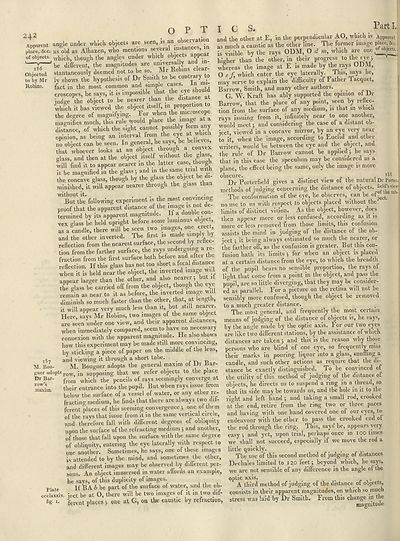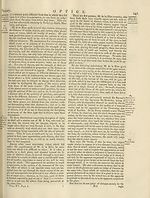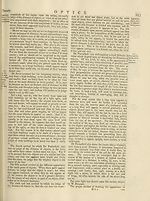Encyclopaedia Britannica > Volume 15, NIC-PAR
(262) Page 242
Download files
Complete book:
Individual page:
Thumbnail gallery: Grid view | List view

P T
186
Objected
to by Mr
Robins.
242 ( ^ . t
Apparent angle under which objects are seen, 13 ^ 0 serv* 10/J
place, &C. as old as Alhazen, who mentions several instances, in
of objects. whichj though the angles under which objects appear
'be different, the magnitudes are universally and in¬
stantaneously deemed not to he so. ^ 1 0 c e
ly shows the hypothesis of Dr Smith to be contrary to
fact in the most common and simple cases. In mi¬
croscopes, he says, it is impossible that the eye should
iudjre the object to be nearer than the distance at
which it has viewed the object itself, in piopoi ion o
the degree of magnifying. For when the microscope
magnifies much, this rule would place the image at a
distance, of which the sight cannot possibly form any
opinion, as being an interval from the eye a w nc 1
no object can be seen. In general, he says, he believe ,
that whoever looks at an object through a convex
glass, and then at the object itself without the glass
will find it to appear nearer in the latter case, though
it be magnified in the glass; and in the same trial with
the concave glass, though by the glass the object be di¬
minished, it will appear nearer through the glass than
without it. . • • „
But the following experiment is the most convincing
proof that the apparent distance of the image ^ not de¬
termined by its apparent magnitude. If a double con¬
vex glass be held upright before some luminous object
as a candle, there will be seen two images, one erect
and the other inverted. The first is made simply by
reflection from the nearest surface, the second by reflec¬
tion from the farther surface, the rays undergoing a re¬
fraction from the first surface both before and after the
reflection. If this glass has not too short a focal distance
when it is held near the object, the inverted image will
appear larger than the other, and also nearer •, but it
the Mass be carried off from the object, though the eye
remain as near to it as before, the inverted image will
diminish so much faster than the other, that, at lengt 1,
k will appear very much less than it, but still nearer.
Here, says Mr Robins, two images of the same object
are seen under one view, and their apparent distances,
when immediately compared, seem to have no necessary
connexion with the apparent magnitude. He also shows
how this experiment may be made still more convincing,
by sticking a piece of paper on the middle of the lens,
and viewing it through a short tube. . r t» -n
i*x. x.uu- M. Bouguer adopts the general maxim of Ur Ilar-
guer adopts row jn supposing that we refer objects to the place
Dr ?ar* from which the pencils of rays seemingly converge at
Z1L their entrance into the pupil. But when rays issue from
' below the surface of a vessel of water, or any other re¬
fracting medium, he finds that there are always two dif¬
ferent places of this seeming convergence j one of them
of the rays that issue from it in the same vertical circle,
and therefore fall with different degrees of obliquity
upon the surface of the refracting medium •, and another,
of those that fall upon the surface with the same degree
of obliquity, entering the eye laterally with respect to
one another. Sometimes, he says, one of these images
is attended to by the mind, and sometimes the other,
and different images may be observed by different per¬
sons. An object immersed in water affords an example,
he says, of this duplicity of images.
Plate If BA b be part of the surface of water, and the ob-
ccckxxiv. ject be at O, there will be two images of it in two dif-
fig- x- ferent places j one at G, on the caustic by refraction,
187
AI. Bou-
I c s. ^ar^ I"
and the other at E, in the perpendicular AO, which is Apparent
as much a caustic as the other line. The former image place, &c.
is visible by the rays ODM, O d m, which are one VJ^
higher than the other, in their progress to the eye j
whereas the image at E is made by the rays ODM,
O e f, which enter the eye laterally. This, says he,
may serve to explain the difficulty of Father lacquet,
Barrow, Smith, and many other authors. .
G. W. Kraft has ably supported the opinion ol Ur
Barrow, that the place of any point, seen by reflec¬
tion from the surface of any medium, is that in which
rays issuing from it, infinitely near to one another,
would meet 5 and considering the case ol a distant ob¬
ject, viewed in a concave mirror, by an eye very near
to it, when the image, according to Euclid and other
writers, would be between the eye and the object, and
the rule of Dr Barrow cannot be applied j he says
that in this case the speculum may be considered as a
plane, the effect being the same, only the image is more
obscure. 1S8
Dr Porterfield gives a distinct view of the natural Dr Porter-
methods of judging concerning the distance of objects, fie^snevl
The conformation of the eye, he observes, can be ot
no use to us with respect to objects placed without the
limits of distinct vision. As the object, however, does
then appear more or less confused, according as it is
more or less removed from those limits, this confusion
assists the mind in judging of the distance of the ob¬
ject •, it being always estimated so much the nearer, or
the farther off, as the confusion is greater. But this con¬
fusion hath its limits ; for when an object is placed
at a certain distance from the eye, to which the breadth
of the pupil bears no sensible proportion, the rays of
lio-ht that come from a point in the object, and pass the
pupil, are so little diverging, that they may be consider¬
ed as parallel. For a picture on the retina will not be
sensibly more confused, though the object be removed
to a much greater distance.
The most general, and frequently the most certain
means of judging of the distance of objects is, he says,
by the angle made by the optic axis. For our two eyes
are like two different stations, by the assistance of which
distances are taken ; and this is the reason why those
persons who are blind of one eye, so frequently miss
their marks in pouring liquor into a glass, snuffing a
candle, and such other actions as require that the di¬
stance be exactly distinguished. To be convinced of
the utility of this method of judging of the distance of
objects, he directs us to suspend a ring in a thread, so
that its side may be towards us, and the hole in it to the
right and left hand *, and taking a small rod, crooked
at the end, retire from the ring two or three paces
and having with one hand covered one of our eyes, to
endeavour with the other to pass the crooked end of
the rod through the ring. This, says* he, appears very
easy j and yet, upon trial, perhaps once in 100 times
we shall not succeed, especially if we move the rod a
little quickly.
The use of this second method of judging of distances
Dechales limited to 120 feet *, beyond which, he says,
we are not sensible of any difference in the angle ot the
optic axis.
A third method of judging of the distance of objects,
consists in their apparent magnitudes, on which so much
stress was laid by Dr Smith. From this change in the
magnitude
186
Objected
to by Mr
Robins.
242 ( ^ . t
Apparent angle under which objects are seen, 13 ^ 0 serv* 10/J
place, &C. as old as Alhazen, who mentions several instances, in
of objects. whichj though the angles under which objects appear
'be different, the magnitudes are universally and in¬
stantaneously deemed not to he so. ^ 1 0 c e
ly shows the hypothesis of Dr Smith to be contrary to
fact in the most common and simple cases. In mi¬
croscopes, he says, it is impossible that the eye should
iudjre the object to be nearer than the distance at
which it has viewed the object itself, in piopoi ion o
the degree of magnifying. For when the microscope
magnifies much, this rule would place the image at a
distance, of which the sight cannot possibly form any
opinion, as being an interval from the eye a w nc 1
no object can be seen. In general, he says, he believe ,
that whoever looks at an object through a convex
glass, and then at the object itself without the glass
will find it to appear nearer in the latter case, though
it be magnified in the glass; and in the same trial with
the concave glass, though by the glass the object be di¬
minished, it will appear nearer through the glass than
without it. . • • „
But the following experiment is the most convincing
proof that the apparent distance of the image ^ not de¬
termined by its apparent magnitude. If a double con¬
vex glass be held upright before some luminous object
as a candle, there will be seen two images, one erect
and the other inverted. The first is made simply by
reflection from the nearest surface, the second by reflec¬
tion from the farther surface, the rays undergoing a re¬
fraction from the first surface both before and after the
reflection. If this glass has not too short a focal distance
when it is held near the object, the inverted image will
appear larger than the other, and also nearer •, but it
the Mass be carried off from the object, though the eye
remain as near to it as before, the inverted image will
diminish so much faster than the other, that, at lengt 1,
k will appear very much less than it, but still nearer.
Here, says Mr Robins, two images of the same object
are seen under one view, and their apparent distances,
when immediately compared, seem to have no necessary
connexion with the apparent magnitude. He also shows
how this experiment may be made still more convincing,
by sticking a piece of paper on the middle of the lens,
and viewing it through a short tube. . r t» -n
i*x. x.uu- M. Bouguer adopts the general maxim of Ur Ilar-
guer adopts row jn supposing that we refer objects to the place
Dr ?ar* from which the pencils of rays seemingly converge at
Z1L their entrance into the pupil. But when rays issue from
' below the surface of a vessel of water, or any other re¬
fracting medium, he finds that there are always two dif¬
ferent places of this seeming convergence j one of them
of the rays that issue from it in the same vertical circle,
and therefore fall with different degrees of obliquity
upon the surface of the refracting medium •, and another,
of those that fall upon the surface with the same degree
of obliquity, entering the eye laterally with respect to
one another. Sometimes, he says, one of these images
is attended to by the mind, and sometimes the other,
and different images may be observed by different per¬
sons. An object immersed in water affords an example,
he says, of this duplicity of images.
Plate If BA b be part of the surface of water, and the ob-
ccckxxiv. ject be at O, there will be two images of it in two dif-
fig- x- ferent places j one at G, on the caustic by refraction,
187
AI. Bou-
I c s. ^ar^ I"
and the other at E, in the perpendicular AO, which is Apparent
as much a caustic as the other line. The former image place, &c.
is visible by the rays ODM, O d m, which are one VJ^
higher than the other, in their progress to the eye j
whereas the image at E is made by the rays ODM,
O e f, which enter the eye laterally. This, says he,
may serve to explain the difficulty of Father lacquet,
Barrow, Smith, and many other authors. .
G. W. Kraft has ably supported the opinion ol Ur
Barrow, that the place of any point, seen by reflec¬
tion from the surface of any medium, is that in which
rays issuing from it, infinitely near to one another,
would meet 5 and considering the case ol a distant ob¬
ject, viewed in a concave mirror, by an eye very near
to it, when the image, according to Euclid and other
writers, would be between the eye and the object, and
the rule of Dr Barrow cannot be applied j he says
that in this case the speculum may be considered as a
plane, the effect being the same, only the image is more
obscure. 1S8
Dr Porterfield gives a distinct view of the natural Dr Porter-
methods of judging concerning the distance of objects, fie^snevl
The conformation of the eye, he observes, can be ot
no use to us with respect to objects placed without the
limits of distinct vision. As the object, however, does
then appear more or less confused, according as it is
more or less removed from those limits, this confusion
assists the mind in judging of the distance of the ob¬
ject •, it being always estimated so much the nearer, or
the farther off, as the confusion is greater. But this con¬
fusion hath its limits ; for when an object is placed
at a certain distance from the eye, to which the breadth
of the pupil bears no sensible proportion, the rays of
lio-ht that come from a point in the object, and pass the
pupil, are so little diverging, that they may be consider¬
ed as parallel. For a picture on the retina will not be
sensibly more confused, though the object be removed
to a much greater distance.
The most general, and frequently the most certain
means of judging of the distance of objects is, he says,
by the angle made by the optic axis. For our two eyes
are like two different stations, by the assistance of which
distances are taken ; and this is the reason why those
persons who are blind of one eye, so frequently miss
their marks in pouring liquor into a glass, snuffing a
candle, and such other actions as require that the di¬
stance be exactly distinguished. To be convinced of
the utility of this method of judging of the distance of
objects, he directs us to suspend a ring in a thread, so
that its side may be towards us, and the hole in it to the
right and left hand *, and taking a small rod, crooked
at the end, retire from the ring two or three paces
and having with one hand covered one of our eyes, to
endeavour with the other to pass the crooked end of
the rod through the ring. This, says* he, appears very
easy j and yet, upon trial, perhaps once in 100 times
we shall not succeed, especially if we move the rod a
little quickly.
The use of this second method of judging of distances
Dechales limited to 120 feet *, beyond which, he says,
we are not sensible of any difference in the angle ot the
optic axis.
A third method of judging of the distance of objects,
consists in their apparent magnitudes, on which so much
stress was laid by Dr Smith. From this change in the
magnitude
Set display mode to:
![]() Universal Viewer |
Universal Viewer | ![]() Mirador |
Large image | Transcription
Mirador |
Large image | Transcription
Images and transcriptions on this page, including medium image downloads, may be used under the Creative Commons Attribution 4.0 International Licence unless otherwise stated. ![]()
| Encyclopaedia Britannica > Encyclopaedia Britannica > Volume 15, NIC-PAR > (262) Page 242 |
|---|
| Permanent URL | https://digital.nls.uk/192585104 |
|---|
| Attribution and copyright: |
|
|---|
| Shelfmark | EB.11 |
|---|---|
| Description | Ten editions of 'Encyclopaedia Britannica', issued from 1768-1903, in 231 volumes. Originally issued in 100 weekly parts (3 volumes) between 1768 and 1771 by publishers: Colin Macfarquhar and Andrew Bell (Edinburgh); editor: William Smellie: engraver: Andrew Bell. Expanded editions in the 19th century featured more volumes and contributions from leading experts in their fields. Managed and published in Edinburgh up to the 9th edition (25 volumes, from 1875-1889); the 10th edition (1902-1903) re-issued the 9th edition, with 11 supplementary volumes. |
|---|---|
| Additional NLS resources: |
|

